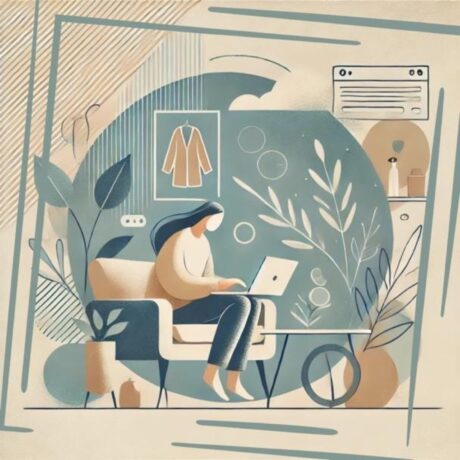The fashion industry needs to break with its gender and women’s rights problems
1%: this equals the percentage of the 250 biggest clothing brands that publish data on the prevalence of gender-based violations in their supplier facilities. It shows the lack of support of women, especially female garment workers and women of colour, and their rights in the fashion industry. Today, on International Women’s Day, it’s time for the industry and policy makers to acknowledge this and to finally act upon it.
Gender inequalities in the fashion supply and production chains
There are approximately 40 to 60 million garment workers in the world today and millions more in other parts of the supply chain, in cotton fields and stores. The majority of those workers are women, thus representing the backbone of an industry worth almost $3 (€2.5) trillion per year today. In the majority of cases, garment workers are paid too low wages to have a decent living, they are subject to countless human rights violations and forced to work overtime in unsafe working conditions. The women behind our clothes face gender-based violence in order to survive and feed their families. Factories often deny their right to maternity leave or child care, and sexual abuse and harrassement in their workplace as well as on their way to work, is commonplace.
Gender wage gap and sticky floor
Despite women representing the majority of textile workers, gender-based wage discrimination happens on a wide scale. According to a 2019 report from the International Labour Organisation (ILO), who has investigated the garment sector in nine countries in Asia, the average raw gender pay gap is approximately 18%. Another 2019 study on garment factories in Bangladesh showed that men get more promoted than women and thus go up the ladder quicker, resulting in a gender wage gap among workers as women are stuck in entry-level positions.
Moreover, to keep prices low and be able to compete, factories often outsource their production to homeworkers, with as much as 60% of garment production done at home in Asia and Latin America. Homeworkers have even fewer rights and bargaining power than factory workers and earn very little for their work. Here again, the vast majority of homeworkers are women.
Unequal chances and glass runway
Throughout the fashion supply chain, men, despite representing a minority, tend to work in better-paid and higher-level positions such as general managers and supervisors. Men also find themselves doing higher-skilled jobs – more valued and paid for – like cutting, because they have more opportunities to learn these new skills than women.
This disparity and gender inequality do not disappear when going up the global fashion production chain, on the contrary. Despite accounting for the vast majority of fashion schools’ students, and making up more than 70% of the total workforce in the fashion industry, women hold less than 25% of leadership positions in top fashion companies. “Only 14% of major brands are run by a female executive”, according to a study by the Council of Fashion Designers of America, Glamour and McKinsey & Company, which highlights the existence of “The Glass Runway” at the top of the fashion industry pyramid.
Female leadership
Women themselves can be the basis of social change in the supply chain, whether they occupy positions at the top, in the middle or at the bottom. In leadership roles they provide better working conditions, a more positive working environment and they can be an example for future female entrepreneurs. In the middle or at the bottom of the supply chain they are indispensable to form unions, and as a result to effectively stand up for women’s and workers’ rights.
The power of collectivity for women
Trade unions are a powerful tool to ensure safer working conditions for workers, protect their rights and negotiate employee’s benefits. This collective bargaining is crucial to improve labour conditions in the garment supply chain. Despite all the challenges faced by women in the garment factories, many are organising themselves to ask for better conditions, in turn empowering other women who might be marginalised or discouraged to act for fear of retaliation in their jobs. Their collective power can help them become stronger and more independent and bring about emancipatory change. In Indonesia, for example, factory workers formed the Inter-Factory Workers’ Federation (FBLP – Federasi Buruh Lintas Pabrik) with a proportion of 90% of women in it. Within the FBLP, the Women Workers Committee fights against abuse and sexual harassment happening in garment factories in KBN Industrial Zone in Cakung. In 2017, after having collected data and spoken up to the police and the Ministry of Women Empowerment and Child Protection, the Women Workers Committee succeeded in setting up posts for complaints and advocacy for women within the factories, as well as warning signs. They are also relentlessly raising awareness and informing the workers about sexual violence and how to eliminate it, empowering the women to fight back.
The importance of entrepreneurship
Entrepreneurship is of great importance especially in the Global South, where women often live in precarious circumstances. It’s often upheld as a solution for numerous problems: it creates wealth and jobs, it offers welfare and can build confidence and status. Entrepreneurship is a mechanism for independence and female entrepreneurship is being seen as a great tool for economic empowerment which also leads to bigger social changes. In recent years, women entrepreneurship or access of women to the business world is the most rapidly growing economic phenomenon in developing nations such as Bangladesh. Investing in these women means investing in a more sustainable future, also in the fashion industry. Investments in local craftsmanship for example for fashion purposes can have a big impact on local communities, more especially for the women in those communities.
Woman at the top
Not only do women represent the people who make our clothes, they also make up the majority of the target audience of the fashion industry. This results in the fact that female leaders generally better understand workers’ and consumers’ needs and wishes than men, which could translate not only into better working conditions and flexibility, but also into more value for the customer and eventually increasing customer satisfaction.
Moreover, female leadership roles in global fashion companies lead to brands being more transparent and having better company culture and higher values. Through providing a safe, comfortable and positive working environment companies can break the stigma around sexual harassment, which is necessary because this is something women who have experienced or witnessed it are still reluctant to talk about and/or report. For the company itself, a positive working environment will of course result in more success in the long run.
Having women at the top of the fashion supply chain also communicates a strong message of independence and empowerment to the outside world. They become an example for those who dream of a job as a leader in a fashion company, which will eventually lead to the diversification of the whole sector. This in turn helps the achievement of the broader Sustainable Development Goals (SDGs) set out by the United Nations, especially goal n°5: “Achieve gender equality and empower all women and girls”.
So what are we waiting for?
Patriarchal societies unfortunately keep women away from their full potential. From research we know the consequences of this situation In the fashion industry: no equal pay, sexual harassment, and so on… . It gives a clear image of those things we want to get rid of so much. And it’s true, change happens slowly, but we need policy makers and brands to take their responsibility seriously. Brands need to acknowledge the power they have as a business and use it to foster positive change. They can, for example, work together with suppliers to tackle gender-related problems and they have to take responsibility for what’s happening in their supply chain. In addition, brands need to become more transparent. That way, NGO’s for example can localise problems faster. Being transparent as a brand isn’t the ultimate goal, but it’s a means to zoom in on these issues and deal with it. Finally we need support and action from policy makers. This week the European Parliament will discuss and vote (on Wednesday) on EU- corporate due diligence. This would make brands accountable for harm caused to people and planet. It could be a big (or even huge) step forward! But here too the condition remains – knowing that this will most likely be implemented by predominantly men – : also zoom in on gender equality and women’s rights.
References
Picture: Woman vector created by freepik – www.freepik.com
Brown, P., Haas, S., Marchessou, S., & Villepelet, C. (2018, October). Shattering the glass runway. https://www.mckinsey.com/industries/retail/our-insights/shattering-the-glass-runway
Business of Fashion. (2015, May 3). How can fashion develop more women leaders? The Business of Fashion. https://www.businessoffashion.com/community/voices/discussions/how-can-fashion-develop-more-women-leaders
Clean Clothes Campaign. (n.d.). Gender Discrimination. https://cleanclothes.org/gender-discrimination
Debnath, G. C., Chowdhury, S., Khan, S., Farahdina, T., & Chowdhury, T. S. (Eds.). (2019). Role of women entrepreneurship on achieving sustainable development goals (SDGs) in Bangladesh (Vol. 10, Issue 5). https://cberuk.com/cdn/conference_proceedings/2020-01-05-09-32-39-AM.pdf
Emran, S. N., & Kyriacou, J. (2017). What She Makes: Power and Poverty in the Fashion Industry. https://whatshemakes.oxfam.org.au/wp-content/uploads/2017/10/Living-Wage-Media-Report_WEB.pdf
Fashion Revolution. (2020, April). Fashion Transparency Index 2020. https://issuu.com/fashionrevolution/docs/fr_fashiontransparencyindex2020
Human Rights Watch. (2019, February 12). Combating Sexual Harassment in the Garment Industry. https://www.hrw.org/news/2019/02/12/combating-sexual-harassment-garment-industry
International Labour Organization. (2019). Promoting Decent Work in Garment Sector Global Supply Chains. https://www.ilo.org/wcmsp5/groups/public/—ed_protect/—protrav/—travail/documents/projectdocumentation/wcms_681644.pdfµ
Labour Behind the Label. (n.d.). Who we are. Retrieved 4 March 2021, from https://labourbehindthelabel.org/who-we-are/
Menzel, A., & Woodruff, C. (2019). Gender Wage Gaps and Worker Mobility: Evidence from the Garment Sector in Bangladesh. National Bureau of Economic Research, 1–57. https://doi.org/10.3386/w25982
Mondiaal FNV. (2017, December 18). The Day The Voices Raised [Video]. YouTube. https://www.youtube.com/watch?v=FOMZMK-bijI
Ojediran, F., & Anderson, A. (2020). Women’s Entrepreneurship in the Global South: Empowering and Emancipating? Administrative Sciences, 10(4), 87. https://doi.org/10.3390/admsci10040087
Parker, J. (2019, December 12). Patriarchal textile industry in Jakarta. ICL-CIT. https://www.icl-cit.org/patriarchal-textile-industry-in-jakarta/
Pathak, D. (2017, August 15). 5 Reasons why India needs more Women Entrepreneurs. YourStory.Com. https://yourstory.com/mystory/f8bbb906ca-5-reasons-why-india-ne
Pike, H. (2016, September 9). Female Fashion Designers Are Still in the Minority. The Business of Fashion. https://www.businessoffashion.com/articles/fashion-week/less-female-fashion-designers-more-male-designers
Schultze, E. (2015). Exploitation or emancipation? Women workers in the garment industry. Fashion Revolution. https://www.fashionrevolution.org/exploitation-or-emancipation-women-workers-in-the-garment-industry/
United Nations. (n.d.). Goal 5 | Department of Economic and Social Affairs. Retrieved 4 March 2021, from https://sdgs.un.org/goals/goal5
WIEGO. (n.d.). Garment Workers. Retrieved 4 March 2021, from https://www.wiego.org/garment-workers








